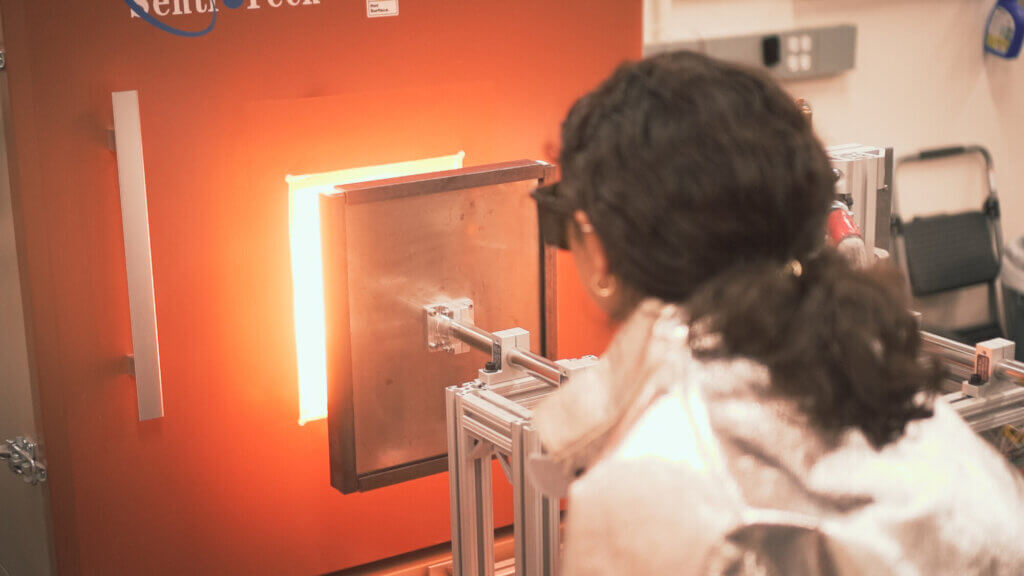
Tips for Making the Leap from University Engineer to Entrepreneur
For engineers and technology experts, the process of becoming a clean energy entrepreneur can be difficult and time-consuming. But it’s often a critical step in getting a new technology solution to market. As a Walton Family Foundation report on technology transfer put it: “Successful research results change the world, but only after they leave the lab.”
Commercializing ideas and inventions developed at universities is often a challenge. Beyond advancing the core research, founders have to create a business plan, raise funds, find customers, hire staff and more.
For engineers and technology experts, the process of becoming a clean energy entrepreneur can be difficult and time-consuming. But it’s often a critical step in getting a new technology solution to market. As a Walton Family Foundation report on technology transfer put it: “Successful research results change the world, but only after they leave the lab.”
The team at New Energy Nexus has learned a few things about how to make this process run smoother as administrators of California Sustainable Energy Entrepreneur Development Initiative (CalSEED), made possible by the California Energy Commission.
“When people talk about commercializing new technology, they always talk about this ‘valley of death,’ where you have to bridge the gap between the technology a university professor is developing in a lab and bringing that technology to market,” said Lorenzo Mangolini, associate professor of mechanical engineering at UC Riverside and CalSEED awardee.
“I think programs like the CalSEED program from New Energy Nexus hit the mark,” he said. “It’s the kind of program you need to at least give ideas a chance to really grow outside of a lab and into a business.”
Mangolini has been working at UC Riverside to develop a new energy storage material that can be easily integrated with existing lithium-ion battery technology to increase storage capacity and battery lifespan. He co-founded the startup SiLi-Ion in 2018 to commercialize the technology. With support from CalSEED and New Energy Nexus, Mangolini developed a business plan and recently brought on renowned advanced manufacturing entrepreneur Mark Hatch as CEO. Going forward, SiLi-Ion plans to manufacture its material in Riverside, California and market it to battery manufacturers all across the globe.

The CalSEED program, which is supported by the California Energy Commission Electric Program Investment Charge (EPIC) funding is designed to back early-stage researchers and entrepreneurs like Mangolini, and not large companies and institutions. That means New Energy Nexus offers a curriculum that’s specially designed to accelerate the work of entrepreneurs, but it also means that the CalSEED program is not intended to work with engineers working within universities. As a result, university-based researchers have to be willing to start their own companies and learn how to become entrepreneurs in order to benefit from the CalSEED program. Making the leap into business is a move that many innovators choose to take, on the path to commercializing their technology.
This was the case for Lorenzo Mangolini at UC Riverside, and two other researchers at California State University, Fullerton who were selected to receive CalSEED grants in 2018. The two universities were officially designated as the grant awardees, not the individuals, which created difficulties in aligning contracting requirements between the universities and CalSEED, and ultimately held up the funding and progress.
There was a breakthrough when administrators at UC Riverside announced that Mangolini could obtain the CalSEED funding separately, without having to go through the university. And CSU Fullerton followed suit. Sarah Chester, grants compliance manager at New Energy Nexus, worked with the respective universities and engineers for more than nine months trying to find a path forward to help getting these innovations out into the world. News that the researchers could receive funding independently was a gamechanger.
This offered the CalSEED team and the engineers a work-around to the existing hold ups. But once the grant was outside of the university infrastructure, the researcher had to quickly figure out how to create their own independent entity to manage the grant. Today, all CalSEED applicants must apply as individuals or companies.
Launching a startup is no easy task, Chester acknowledged. Some of the engineers she works with at New Energy Nexus are justifiably nervous about becoming entrepreneurs. “It’s a big, risky move and an enormous change,” she said.
But, luckily, there are ways to make the process easier.
>> Tips for new entrepreneurs
Partner with an MBA student
Joy Larson, program director for CalSEED, said that most of the program’s awardees have a science and engineering background. So, one of the best things they can do to jumpstart their startup is partner with an MBA student who is equally motivated to see the technology succeed.
In starting to craft their business plan, many engineers realize that it’s not their sweet spot or something they enjoy doing, said Larson, “but they recognize the value and importance of someone who can run the books, apply for grants, manage compliance, talk to donors and partners and build your supply chain.”
It can be hard for some founders to let go of a piece of their company. But without help, founders can develop blind spots, Larson said. Plus, she said there are plenty of MBA students who want to work in clean energy and build a company from the ground up.
Leverage university resources
According to Mangolini, it’s important for university researchers to push their university administrators for help. Virtually all schools have a business development branch, but some are less aggressive than others. For many schools, the focus is on teaching and not spinning out startups, but that doesn’t mean there aren’t business resources available.
UC Riverside, for instance, has a network of entrepreneurs in residence — people who have been in the Southern California business community for several years and are taking time out of their schedules to mentor professors and post-docs. This network proved invaluable as Mangolini and his team crafted their applications for CalSEED and other grants. So, while the university would not accept the terms of the CalSEED contract, which created some bureaucratic issues early on, the school did make sure to offer support in terms of advice and mentorship.
“What I would recommend to other professors, is to be as annoying as possible with the upper management to your university,” said Mangolini. “Because they should be able to give you resources, especially in terms of contacts within the business community.”
“Let’s be honest, building a business case takes a lot of time and people who are very much into science and technology are focused on science and technology,” he added. “So, it’s not something you can do on your own.”
Rely on the New Energy Nexus network
When launching a company, there are lessons to be learned at every step along the way. Reaching out to other entrepreneurs and gaining takeaways from their experiences is a great way to fast-track the learning process, said Chester. But while this may seem obvious, it’s not always easy.
“There is always competition between companies,” she said. “Our goal at CalSEED is to create opportunities among our cohorts of entrepreneurs to build collaboration and a sense of community, with that, we have seen that the competitive spirit kind of goes away. We advise new entrepreneurs to reach out to others so they can help each other with their growing pains or the nervousness that’s created when you’re jumping in feet first into this new world of entrepreneurship.”
New Energy Nexus has worked hard to create an environment where CalSEED awardees can connect and learn from each other in a positive setting. While meet and greets have become a challenge amid the coronavirus pandemic, New Energy Nexus is finding new ways to help entrepreneurs build support systems through webinars and other online channels, such as the CEC Empower Innovation Network. Entrepreneurs can also access the New Energy Network Slack community and participate in global convenings by joining the New Energy Nexus mailing list.
“I always think it’s magical because we have companies that are more advanced and have been through so many different bumpy roads, and then we have companies that are just starting to actualize their idea from a napkin and are navigating the process of creating a company to get this funding opportunity,” said Chester. “The helping hand that these companies lend to each other is just amazing.”
“Even it’s just, ‘Call me and I’ll help you walk through some of these things,’” she continued. “It’s really, really important and something that I think is sort of the “secret sauce” to the larger wraparound services that the CalSEED program offers.”
CalSEED’s additional wraparound services include, networking events, pitch opportunities and mentoring and coaching through Open Office, an online resource hub. The team is also currently working to create a new workshop series focused specifically on business development and how to grow a company. Chester said this workshop should serve as a “tool chest” for how to approach everything from HR support and accounting to equity and inclusion policies.
>> Take the plunge!
Before embarking on the entrepreneurship journey, Mangolini advises scientists and engineers to think carefully about the technology they’re working on and to make sure they’re confident in the its potential.
“You need to have absolute trust in the technology, because launching a business requires a significant time investment,” he said.
The COVID-19 pandemic has created additional uncertainties for new entrepreneurs, said Joy Larson. But she underscored that the urgency to develop and commercialize new technologies to combat climate change and accelerate the energy transition has not changed. At the same time, programs like CalSEED, as well as CalTestBed — the regional innovation clusters in California — provide a robust support network for people who want to “take the plunge.”
Mangolini said that creating a company was always part of his vision, but that the CalSEED award it made it happen faster.
“Using the knowledge we gained from CalSEED, we were able to come up with a search process for a CEO, and ultimately recruit a really top notch CEO to take over a lot of the business development, which is really important,” he said. “Without the credibility of the grant from CalSEED I think recruiting a great CEO would have been more difficult.”
The grant continues to serve as an important stamp of approval as SiLi-Ion embarks on the fundraising process and taking its technology from the lab to the market.
“There is no one single magic recipe to make this work,” Mangolini said of becoming an entrepreneur and launching a startup. “But what New Energy Nexus is doing is creating a network and giving you a playbook for what it will take to create a business.”

